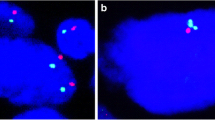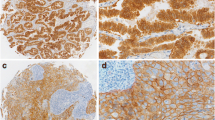Abstract
FGFR1 amplification has been identified recently as an important therapeutic target in non-small-cell lung cancer (NSCLC), particularly squamous cell carcinoma (SqCC). However, data from previous studies on the clinical implications of FGFR amplification in NSCLC are inconsistent. We evaluated FGFR1 gene copy number (GCN) in 369 cases of surgically resected NSCLC using five previously reported criteria and investigated associations between clinicopathologic parameters and FGFR1 amplification. FGFR1 amplification was found in 32/369 (8.7 %) of NSCLC and was more frequent in SqCC (18.0 % in SqCC, 3.0 % in adenocarcinoma; p < 0.001) and in smokers (p < 0.001). On univariate analysis, FGFR1 amplification was significantly associated with shorter overall survival (OS, 58.6 vs 80.0 months; p = 0.033) and shorter disease-free survival (DFS, 58.5 vs 80.0 months; p = 0.042) in patients with SqCC, but this was not statistically significant on multivariate analysis (OS: hazard ratio [HR] = 1.79, 95 % confidence interval [CI] = 0.83–3.87, p = 0.139; DFS: HR = 1.73, 95 % CI = 0.93–3.21, p = 0.081). The correlation between FGFR1 amplification and protein expression was poor (rho = 0.08; p = 0.123). These results suggest that FGFR1 amplification is associated with smoking history and squamous cell carcinoma histology and might indicate poor prognosis.




Similar content being viewed by others
References
Kim HS, Mitsudomi T, Soo RA, Cho BC (2013) Personalized therapy on the horizon for squamous cell carcinoma of the lung. Lung Cancer 80(3):249–255. doi:10.1016/j.lungcan.2013.02.015
Kim HR, Kim DJ, Kang DR, Lee JG, Lim SM, Lee CY, Rha SY, Bae MK, Lee YJ, Kim SH, Ha SJ, Soo RA, Chung KY, Kim JH, Lee JH, Shim HS, Cho BC (2013) Fibroblast growth factor receptor 1 gene amplification is associated with poor survival and cigarette smoking dosage in patients with resected squamous cell lung cancer. J Clin Oncol 31(6):731–737. doi:10.1200/jco.2012.43.8622
Kohler LH, Mireskandari M, Knosel T, Altendorf-Hofmann A, Kunze A, Schmidt A, Presselt N, Chen Y, Petersen I (2012) FGFR1 expression and gene copy numbers in human lung cancer. Virchows Arch 461(1):49–57. doi:10.1007/s00428-012-1250-y
Young RJ, Lim AM, Angel C, Collins M, Deb S, Corry J, Wiesenfeld D, Kleid S, Sigston E, Lyons B, Russell PA, Wright G, McArthur GA, Fox SB, Rischin D, Solomon B (2013) Frequency of Fibroblast Growth Factor Receptor 1 gene amplification in oral tongue squamous cell carcinomas and associations with clinical features and patient outcome. Oral Oncol 49(6):576–581. doi:10.1016/j.oraloncology.2013.01.006
Dutt A, Ramos AH, Hammerman PS, Mermel C, Cho J, Sharifnia T, Chande A, Tanaka KE, Stransky N, Greulich H, Gray NS, Meyerson M (2011) Inhibitor-sensitive FGFR1 amplification in human non-small cell lung cancer. PLoS One 6(6):e20351. doi:10.1371/journal.pone.0020351
Schildhaus HU, Heukamp LC, Merkelbach-Bruse S, Riesner K, Schmitz K, Binot E, Paggen E, Albus K, Schulte W, Ko YD, Schlesinger A, Ansen S, Engel-Riedel W, Brockmann M, Serke M, Gerigk U, Huss S, Goke F, Perner S, Hekmat K, Frank KF, Reiser M, Schnell R, Bos M, Mattonet C, Sos M, Stoelben E, Wolf J, Zander T, Buettner R (2012) Definition of a fluorescence in-situ hybridization score identifies high- and low-level FGFR1 amplification types in squamous cell lung cancer. Mod Pathol Off J U S Can Acad Pathol Inc 25(11):1473–1480. doi:10.1038/modpathol.2012.102
Sugiura K, Ozawa S, Kitagawa Y, Ueda M, Kitajima M (2007) Co-expression of aFGF and FGFR-1 is predictive of a poor prognosis in patients with esophageal squamous cell carcinoma. Oncol Rep 17(3):557–564
Ishizuka T, Tanabe C, Sakamoto H, Aoyagi K, Maekawa M, Matsukura N, Tokunaga A, Tajiri T, Yoshida T, Terada M, Sasaki H (2002) Gene amplification profiling of esophageal squamous cell carcinomas by DNA array CGH. Biochem Biophys Res Commun 296(1):152–155
Brunello E, Brunelli M, Bogina G, Calio A, Manfrin E, Nottegar A, Vergine M, Molino A, Bria E, Massari F, Tortora G, Cingarlini S, Pedron S, Chilosi M, Zamboni G, Miller K, Martignoni G, Bonetti F (2012) FGFR-1 amplification in metastatic lymph-nodal and haematogenous lobular breast carcinoma. J Exp Clin Cancer Res 31:103. doi:10.1186/1756-9966-31-103
Jang MH, Kim EJ, Choi Y, Lee HE, Kim YJ, Kim JH, Kang E, Kim SW, Kim IA, Park SY (2012) FGFR1 is amplified during the progression of in situ to invasive breast carcinoma. Breast Cancer Res 14(4):R115. doi:10.1186/bcr3239
Yang F, Zhang Y, Ressler SJ, Ittmann MM, Ayala GE, Dang TD, Wang F, Rowley DR (2013) FGFR1 is essential for prostate cancer progression and metastasis. Cancer Res 73(12):3716–3724. doi:10.1158/0008-5472.can-12-3274
Goldstein M, Meller I, Orr-Urtreger A (2007) FGFR1 over-expression in primary rhabdomyosarcoma tumors is associated with hypomethylation of a 5' CpG island and abnormal expression of the AKT1, NOG, and BMP4 genes. Genes Chromosome Cancer 46(11):1028–1038. doi:10.1002/gcc.20489
Liu J, Guzman MA, Pezanowski D, Patel D, Hauptman J, Keisling M, Hou SJ, Papenhausen PR, Pascasio JM, Punnett HH, Halligan GE, de Chadarevian JP (2011) FOXO1-FGFR1 fusion and amplification in a solid variant of alveolar rhabdomyosarcoma. Mod Pathol Off J U S Can Acad Pathol Inc 24(10):1327–1335. doi:10.1038/modpathol.2011.98
Weiss J, Sos ML, Seidel D, Peifer M, Zander T, Heuckmann JM, Ullrich RT, Menon R, Maier S, Soltermann A, Moch H, Wagener P, Fischer F, Heynck S, Koker M, Schottle J, Leenders F, Gabler F, Dabow I, Querings S, Heukamp LC, Balke-Want H, Ansen S, Rauh D, Baessmann I, Altmuller J, Wainer Z, Conron M, Wright G, Russell P, Solomon B, Brambilla E, Brambilla C, Lorimier P, Sollberg S, Brustugun OT, Engel-Riedel W, Ludwig C, Petersen I, Sanger J, Clement J, Groen H, Timens W, Sietsma H, Thunnissen E, Smit E, Heideman D, Cappuzzo F, Ligorio C, Damiani S, Hallek M, Beroukhim R, Pao W, Klebl B, Baumann M, Buettner R, Ernestus K, Stoelben E, Wolf J, Nurnberg P, Perner S, Thomas RK (2010) Frequent and focal FGFR1 amplification associates with therapeutically tractable FGFR1 dependency in squamous cell lung cancer. Sci Transl Med 2(62):62ra93. doi:10.1126/scitranslmed.3001451
Turner NC, Seckl MJ (2010) A therapeutic target for smoking-associated lung cancer. Sci Transl Med 2(62):62ps56. doi:10.1126/scitranslmed.3001942
Tran TN, Selinger CI, Kohonen-Corish MR, McCaughan BC, Kennedy CW, O'Toole SA, Cooper WA (2013) Fibroblast growth factor receptor 1 (FGFR1) copy number is an independent prognostic factor in non-small cell lung cancer. Lung Cancer. doi:10.1016/j.lungcan.2013.05.015
Zhang J, Zhang L, Su X, Li M, Xie L, Malchers F, Fan S, Yin X, Xu Y, Liu K, Dong Z, Zhu G, Qian Z, Tang L, Zhan P, Ji Q, Kilgour E, Smith PD, Brooks AN, Thomas RK, Gavine PR (2012) Translating the therapeutic potential of AZD4547 in FGFR1-amplified non-small cell lung cancer through the use of patient-derived tumor xenograft models. Clin Cancer Res 18(24):6658–6667. doi:10.1158/1078-0432.ccr-12-2694
Gozgit JM, Wong MJ, Moran L, Wardwell S, Mohemmad QK, Narasimhan NI, Shakespeare WC, Wang F, Clackson T, Rivera VM (2012) Ponatinib (AP24534), a multitargeted pan-FGFR inhibitor with activity in multiple FGFR-amplified or mutated cancer models. Mol Cancer Ther 11(3):690–699. doi:10.1158/1535-7163.mct-11-0450
Heist RS, Mino-Kenudson M, Sequist LV, Tammireddy S, Morrissey L, Christiani DC, Engelman JA, Iafrate AJ (2012) FGFR1 amplification in squamous cell carcinoma of the lung. J Thorac Oncol 7(12):1775–1780. doi:10.1097/JTO.0b013e31826aed28
Sasaki H, Shitara M, Yokota K, Hikosaka Y, Moriyama S, Yano M, Fujii Y (2012) Increased FGFR1 copy number in lung squamous cell carcinomas. Mol Med Rep 5(3):725–728. doi:10.3892/mmr.2011.715
Travis WD (2004) Pathology & genetics: tumours of the lung, pleura, thymus, and heart, vol 7. Iarc
Travis WD, Brambilla E, Noguchi M, Nicholson AG, Geisinger KR, Yatabe Y, Beer DG, Powell CA, Riely GJ, Van Schil PE, Garg K, Austin JH, Asamura H, Rusch VW, Hirsch FR, Scagliotti G, Mitsudomi T, Huber RM, Ishikawa Y, Jett J, Sanchez-Cespedes M, Sculier JP, Takahashi T, Tsuboi M, Vansteenkiste J, Wistuba I, Yang PC, Aberle D, Brambilla C, Flieder D, Franklin W, Gazdar A, Gould M, Hasleton P, Henderson D, Johnson B, Johnson D, Kerr K, Kuriyama K, Lee JS, Miller VA, Petersen I, Roggli V, Rosell R, Saijo N, Thunnissen E, Tsao M, Yankelewitz D (2011) International association for the study of lung cancer/american thoracic society/european respiratory society international multidisciplinary classification of lung adenocarcinoma. J Thorac Oncol 6(2):244–285. doi:10.1097/JTO.0b013e318206a221
Edge SB, Byrd DR, Compton C, Fritz A, Greene F, Trotti A (2010) American joint committee on cancer staging manual. American Joint Committee on Cancer Staging Manual
Yoo SB, Chung JH, Lee HJ, Lee CT, Jheon S, Sung SW (2010) Epidermal growth factor receptor mutation and p53 overexpression during the multistage progression of small adenocarcinoma of the lung. J Thorac Oncol 5(7):964–969. doi:10.1097/JTO.0b013e3181dd15c0
Kim H, Yoo SB, Sun P, Jin Y, Jheon S, Lee CT, Chung JH (2013) Alteration of the E-cadherin/beta-catenin complex is an independent poor prognostic factor in lung adenocarcinoma. Korean J Pathol 47(1):44–51. doi:10.4132/KoreanJPathol.2013.47.1.44
Kono SA, Heasley LE, Doebele RC, Camidge DR (2012) Adding to the mix: fibroblast growth factor and platelet-derived growth factor receptor pathways as targets in non-small cell lung cancer. Curr Cancer Drug Targets 12(2):107–123
Clinical LCGPC, Network GMN (2013) A genomics-based classification of human lung tumors. Sci Transl Med 5(209):209ra153
Pros E, Lantuejoul S, Sanchez-Verde L, Castillo SD, Bonastre E, Suarez-Gauthier A, Conde E, Cigudosa JC, Lopez-Rios F, Torres-Lanzas J, Castellvi J, Ramon y Cajal S, Brambilla E, Sanchez-Cespedes M (2013) Determining the profiles and parameters for gene amplification testing of growth factor receptors in lung cancer. Int J Cancer J Int Cancer 133(4):898–907. doi:10.1002/ijc.28090
Takanami I, Tanaka F, Hashizume T, Kodaira S (1997) Tumor angiogenesis in pulmonary adenocarcinomas: relationship with basic fibroblast growth factor, its receptor, and survival. Neoplasma 44(5):295–298
Hsu FD, Nielsen TO, Alkushi A, Dupuis B, Huntsman D, Liu CL, van de Rijn M, Gilks CB (2002) Tissue microarrays are an effective quality assurance tool for diagnostic immunohistochemistry. Mod Pathol Off J U S Can Acad Pathol Inc 15(12):1374–1380. doi:10.1097/01.mp.0000039571.02827.ce
Voduc D, Kenney C, Nielsen TO (2008) Tissue microarrays in clinical oncology. Semin Radiat Oncol 18(2):89–97. doi:10.1016/j.semradonc.2007.10.006
Acknowledgments
This study was supported by the grant no. 14-2014-032 from the Seoul National University Bundang Hospital and partly supported by a grant in-aid from Basic Science Research Program through the National Research Foundation of Korea (NRF) funded by the Ministry of Education (2013-059757). The authors are indebted to J. Patrick Barron, Professor Emeritus, Tokyo Medical University, and Adjunct Professor, Seoul National University Bundang Hospital, for his pro bono editing of this manuscript.
Conflict of interest
The authors declare no conflicts of interest.
Author information
Authors and Affiliations
Corresponding author
Rights and permissions
About this article
Cite this article
Seo, A.N., Jin, Y., Lee, H.J. et al. FGFR1 amplification is associated with poor prognosis and smoking in non-small-cell lung cancer. Virchows Arch 465, 547–558 (2014). https://doi.org/10.1007/s00428-014-1634-2
Received:
Revised:
Accepted:
Published:
Issue Date:
DOI: https://doi.org/10.1007/s00428-014-1634-2




